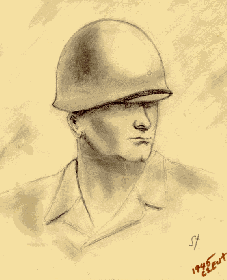
My trip through World War II, covering the period from June 25, 1941 to December 10, 1945 when I was discharged from the U.S. Army as a 1st Sgt. in the 53rd Armored Engineers of the 8th Armored Division. The 1940 Draft Registration with Draft Number 3314 had me scheduled for drafting into the U.S. Army sometime in 1941. It was a question of when my number was going to come up. I was working as a Core Assembler in the Sanford Street Plant of the Campbell Wyant and Cannon Foundry. It looked like I would be called up in May so I quit my job at the C.W. & C. Foundry at the end of April. I had made up my mind that I was going to enjoy myself before I was called up to serve my "stretch" in the service.
However the fickle finger of fate intervened and I was not called up in May. I missed the May call up by a few numbers. This gave me more free time and an extra month of free time roller-skating and nightlife with my friends, Kenny Tufts and Joe Cirner. I got my notice to leave on June 25th and on that summer evening over 200 of us assembled at the Muskegon Armory before a large crowd of parents, friends, and relatives. We were going to the Army.
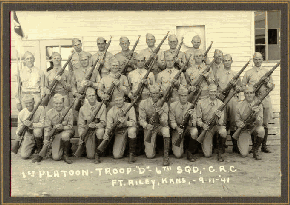
The only luggage allowed was a small bag to carry our shaving supplies, tooth brush and small personal items. We were over 200 strong and I recognized many familiar faces amongst the draftees. There were lots of very emotional scenes with family and friends. The Jozsa's, the Vida's and the Vokits family were all there to see the Johns and Steve off (John Vida & John Jozsa). After some official ceremonies, the three Greyhound buses pulled out of the Muskegon Armory Parking Lot and headed south for Kalamazoo and Camp Custer. First stop hopefully the Hotel Burdick in Kalamazoo, for just overnight. The weather was warm and clear. However, there was an unscheduled stop in between Muskegon and Kalamazoo. I say that it was an unscheduled stop in Holland, which was not planned by the U.S. Army. The stop was made on a forceful request by one Steve "Fumbles" Radakovitz. "Fumbles", all 300 lbs. of him, happened to be the "town character", bar room brawler and noted for his many escapades around Muskegon. He was well known by all of the local Police Departments. In fact he had celebrated his Draft Call up with a wild night on the town. He celebrated his call-up by tearing up a local nightclub and had ended up in a local jail on drunk and disorderly charges. In fact it was said that he had been brought to the Armory from the local jail.
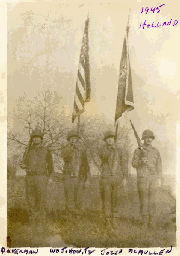
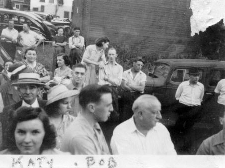
I knew "Fumbles", as he was a Croatian from the neighborhood. He regarded me as one of his friends. I surely never challenged him on his nights out. As we approached the city of Holland, "Fumbles" went up to the Bus Driver and "advised" him to stop at the first place where we could buy packaged liquor.
The driver at first refused but as the 300-lb. "Fumbles" threatened violence, the unconvinced driver became convinced and stopped for the "Liquor Stop". Fumbles left the bus with one of his draftee buddies and came back soon with 2 cases of liquors. The other two buses did not stop. They did not have a "Fumbles" on board. Well, needless to say, some of the bottles were "opened" and by the time we got to the Burdick Hotel in Kalamazoo, some of the draftees were feeling very good and mellow. We got to the Hotel and were met by U.S. Army Personnel who checked us into our rooms and gave us details as to what would happen to us in the next few days.


After we checked out our rooms, "Fumbles" organized a group to go out on the town as our "last fling" sort of thing. Being a friend and having the room next to "Fumbles", I was invited to go along. We went to a local nightclub and celebrated our last night as civilians, knowing that the next morning we would be members of the U.S. Army.
The nightclub closed and the "Fumbles" group ended up at an illegal after hours club that a Cab Driver took us to. We continued to party and got back to our hotel room in the very wee hours of the morning. I saw "Fumbles" back to his room and he was handing out his whiskey to his friends. He figured that he would be unable to cart it around as a new private in the U.S. Army. I thus ended up with two bottles of Canadian Club in my little bag. My time in the U.S. Army had begun.

At a very early hour, they loaded us on Army buses and took us out to Camp Custer and introduced us officially to the real U.S. Army.
They fed us, clothed us, and gave us physicals. As an Army Doctor checked "Fumbles", he warned the other Doctors not to light any matches around Fumbles as he reeked so strongly of whiskey. Needless to say, "Fumbles" did not pass his physical and he was sent back to Muskegon on the next bus.
After our physicals we were given hours of tests. I later found out that these were Army General Classification Tests whose scores would follow you all throughout your Army Career. Your scores would in many cases determine your future assignment and Army Specification Number. These scores would become a very important item in your Army 201 Permanent File.
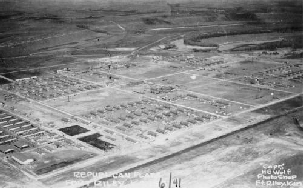
I must have scored fairly well because I later found out that I had scored high enough for going to an Officer Candidate School. We were also issued G.I. equipment (Government Issue) and clothing and were started on our series of shots.
The first two days at Fort Custer gave us the real introduction to the U.S. Army. Rumors, commonly called "Latrinograms" were flying as to where we would go next as Camp Custer was just a processing and induction center (a latrine is an army restroom).
During all this time I had the two bottles of whiskey in my little bag, always wondering what would happen to me if the U.S. Army found out about them. I guarded my little bag with its contents.
After two days of processing we finally got our orders to ship out, not knowing where we were going. We did head west by Railroad Transit. The cars were very old, probably dated from the 1920's. Our destination was unknown. The cars were dirty. It was hot. I remember the cinders from the locomotive would seep in around the windows of the cars. The cars could even been resurrected from World War I. Food was served on board. It was army prepared food. You eat it or you go hungry. So you eat it. This was our first introduction to the U.S. Army Mess Kit where all the food is mixed right in front of you as you go through the "mess line".

After about two days of travel, being switched off while more important trains to the war effort passed by; we finally ended up in Kansas. We saw signs designating Camp Funston, Fort Riley and finally (C.R.T.C.) the Cavalry Replacement Training Center at Republican Flats, Kansas.
The Camps Barracks Area looked fairly new. We later found out that we were the second group of draftees to be trained here. Trucks picked us up and took us to our Barracks Area. It was our introduction to my one year in Kansas. It was hot and very dry. I was not looking forward to my time in Kansas. We got off the trucks and were placed in formation for our introduction to our Basic Training Camp and our Commissioned and Non-commissioned Officers who would handle our instruction.
The First Sgt. introduced himself as 1st Sgt. Underwood. He told us that he was an old Horse Cavalry Soldier and was not too happy with having to teach raw recruits and draftees at that being raw recruits not volunteers but draftees.
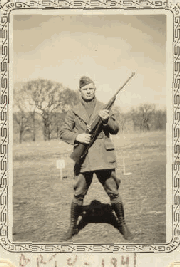
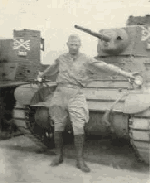
What he said next had me shaking in my shoes. In the Cavalry we were later issued boots to replace our shoes. The First Sgt. then announced; "As you might have heard, Kansas is a 'dry' state and the possession of whiskey is illegal and it is also illegal to have it on any army base." Can you imagine how I felt at that moment? I pictured myself doing hard time in a Federal Prison. The First Sgt. then released my tension by saying, "If you have any alcoholic beverages, see me after this formation. Then he smiled for the first time and I was very relieved while I thought about the two bottles of Canadian Club in the bag I was holding at my side.
The story of my "two bottles" was not yet over. There was more. That night, the first night in Kansas, just after lights went out in the barracks as I lay on my army cot someone was shaking me to see if I was awake. The voice told me, "I hear that you have some drinking whiskey". He told me that he was Corporal Volz and was the Non-Com Officer in charge of that barracks and that his room was at the end of the barracks and could I please come to his room with a bottle of that whiskey. Well, how could I refuse his request? I wrapped one of the bottles in my towel and went down to see Cpl. Volz. It was the start of a very worthwhile relationship. In the service, as in civilian life, it does pay to know the right people, that is to get along and out of some of the dirty details that army privates are assigned to. That first night in Kansas made Kansas and Basic Training easier for one John Jozsa, all because of Canadian Club.
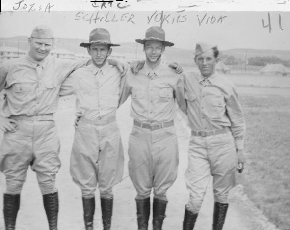
The next few days consisted of our introductions to the United States Cavalry. We were the second group of draftees to be sent through the Cavalry Replacement Training Center. The U.S. Army was still relying on the Horse Cavalry although Hitler's Tank and Armored Corps was forcing the U. S. to look favorably on more tanks and armor.
We were issued laced boots and the broad brimmed Campaign Hats, felt like a cowboy. About half of the Muskegon Draft group ended up in the Horse Cavalry for their Basic Training. Three of my close friends from the group, Andy Kandalec, Steve Vokits (my next door neighbor) and Joe Schiller, trained with the horses.
I ended up in the Mechanized Vehicle Section for my training. I remember as I went through the classification that a 250 Negro Sgt. looked at my 205 physique and made the big decision. I still remember his words that saved me from the Horse Cavalry "You're too fucking big for a horse " and then he officially assigned me to mechanized training. What a nice break. A year later in 1942 the U.S. Army started to phase out the Horse Cavalry and started to put the emphasis on Armored Divisions.

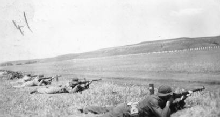
All of my friends who trained with the horses all eventually ended up in armor. Later in my army career I became involved in (Cadre) training non-commissioned officers and officers for the 8th, 9th, 10th, 11th, 12th, 13th, 14th, 16th, and 20th Armored Divisions.
Cavalry Basic Training was 13 weeks long and a lot of time was spent in Close Order Drill (Marching), Military courtesy, Physical Conditioning and the various weapons training.


The weapons we became very familiar with were the 45 Colt Pistol, the 1903 Springfield Rifle and the 30 Cal. Machine Guns, both the air cooled and water cooled. The 81-millimeter Mortar and the 50 Cal. Machine-Gun.
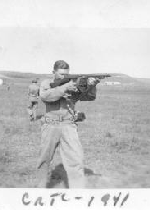
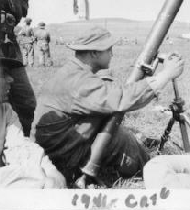
We also did a lot of training with the bayonet. The bayonet was considered the ultimate weapon for close in combat and in hand to hand fighting. I poked and slashed at those straw dummies for hours. I found out first hand about the dangers of bayonet fighting through an incident where one of my partners in a bayonet drill finished me off with a butt stroke with his rifle stock. He really hit me (Butt). It hurt and loosened one of my teeth. Two days later the tooth became abscessed; an Army Dentist pulled the infected tooth. The Army was graciously agreed to give me a partial plate with one tooth on it. The Army would not give me a permanent bridge. The plate drove me crazy. One night in town while eating a hamburger, the plate got tangled up with the burger. Needless to say, the plate broke into 3 pieces. The Army agreed to replace the plate but refused to install a permanent bridge.


Since the missing tooth was in front I wanted a permanent bridge. I also was scheduled for a furlough in December of 1941 . . . I needed it done soon.
My army dentist was sympathetic to my problem and made an appointment with a civilian dentist in Junction City. Junction City is adjacent to the Army Camp.
The civilian dentist installed a permanent gold bridge with two small "facing" teeth which I have to this day. I've had to replace the facings three or four times throughout the past fifty odd years. (The bridge has held up).


Junction City was the closest town to C.R.T.C. During the first part of Basic Training we were restricted to the Military Reservation. Eventually we were allowed to go into the town of Junction City. Before we were allowed to go to town we spent most of our after work hours drinking 3.2 beer at the P.X. (Post Exchange). I found out that the town did have a Roller Skating Rink. Being a fairly good Roller Skater, even knowing most of the skate dances helped. I had no trouble finding partners to skate with and to become friends with. I still remember Goldie, an excellent skater. Her & I did the dances. I have her picture in one of my albums. Out skating ended there in the fall of 1941 when the Republican River overflowed and the skating floor was less than two feet of water. The floor was completely ruined and was never rebuilt. I had my skates sent to me in Kansas and spent a weekend pass in Kansas City and did skate at the famous Playmor Roller Rink. The Playmor was a large entertainment complex. The Rink was just a part of the complex. Did some of the Skate Dances at the Playmor.
|